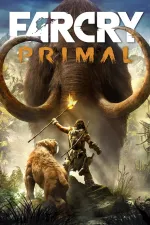Please support Game Informer. Print magazine subscriptions are less than $2 per issue
Far Cry Primal
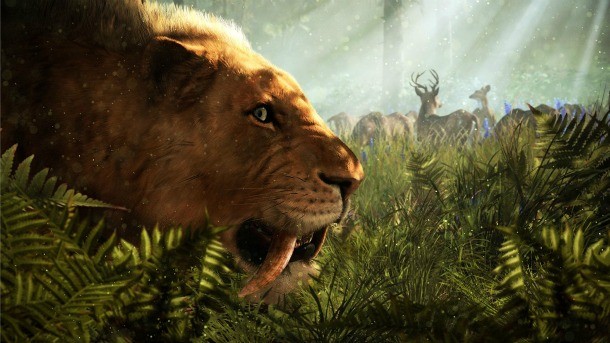
Editor's Note: The following article first appeared in Game Informer Australia Issue #75 and is written by David Milner. You can follow him on Twitter here.
It begins with a bang. Or, more accurately, a crushing thud to the ground. Takkar, Far Cry Primal’s protagonist, is chased off a cliff when a sabre-toothed tiger rudely interrupts his mammoth-hunting expedition. His party is slaughtered. After regaining consciousness and realizing he’s been separated from the safety of his tribe, the Wenja, Takkar has to quickly satisfy his most primal, urgent needs: find a weapon, find food, find shelter and find his people.
There are no complex emotions or themes at play during the game’s scene-setting moments. Takkar is not returning to his homeland to bury his mother; he’s not liberating a nation from a totalitarian regime; he’s not even a carefree frat-brat on a holiday from Hell. He just needs to stay alive in a land that couldn’t care less about him.
“It’s more direct. There are more immediate concerns,” says Kevin Shortt, lead writer on Far Cry Primal – a man with the unusual task of crafting dialogue for a game that doesn’t feature a single word spoken in a living, real language.
After spending four hours with Far Cry Primal, exploring its open-world and diving into its new features, I can attest that it simultaneously feels like a Far Cry game and a new experience. The core franchise pillar of surviving a hostile frontier is omnipresent – but this isn’t just any frontier. This is the first frontier.
“We want it so that when players go into this world, they really feel like they’re in the period of 10,000 BCE,” says Shortt. “The animals are very accurate and precise. A lot of research went into what they looked like... The trees are massive... The glaciers are huge. That’s to help give you the sense that you’re not the top of the food chain in this world.”
An elevated vantage point, a sun-drenched vista over a glacial valley and a herd of mammoths roaming below makes it clear just how alien and hostile this place is. Far Cry has always toyed with the theme of being a stranger in a strange land – but this is the strangest land.
“Even though the narrative is more base, and survival is a much more important theme, we still wanted to make sure we have the humanity of today,” Shortt explains.
Despite the strictures of primitive language and 12,000 fewer years of evolutionary development, Shortt says that there’s “still room for complexity in the game’s characters.” This soon becomes apparent. After crafting a bow from scrounged resources and hunting deer to recover health, Takkar picks up the trail of his people using his Hunter’s Vision (similar to Batman: Arkham’s Detective Mode), and follows the tracks into the land of Oros. Before long, he encounters Sayla, a fierce Wenja woman wearing a necklace adorned with severed ears – presumably the height of fashion at the time.
“Sayla is basically suffering from PTSD,” explains Shortt. “No one will articulate it that way, of course, but as you get to know her story you realize she’s got this weird ‘whispering into the ears’ thing going on. She’s hearing voices. When you start to learn her story, you’re going to understand why. She’s seen this horrible destruction of her tribe. She believes that everyone is hearing the voices.”
Like almost everyone else in Far Cry Primal, Sayla is in the process of being mauled by a prehistoric beast when Takkar first encounters her. One heroic intervention later, and the pair make their escape together.
Sayla explains to Takkar that the Wenja in Oros have been driven apart by Ull, the orc-like leader of the hostile Udam people. Ull has declared war on the Wenja, decimating their settlements and spreading their people to the ends of the realm. As luck would have it, it’s up to Takkar to reunite the Wenja tribe.
Sayla leads Takkar to the primeval comforts of a campfire and the safety of her cave – the beginnings of a much larger settlement, and a key new system in Far Cry Primal.
Building A Tribe
Dotted across the open-world of Oros, wise and skillful individuals await discovery. Ubisoft refers to these people as “specialists.” Completing quests for a specialist convinces them to travel back to your burgeoning village, where they build themselves a basic hut and settle into your tribe. This, in turn, attracts others to your upstart settlement, increasing its strength and renown. Before long, Takkar and Sayla’s campfire will grow into a fully-fledged community.
Each of these specialists can teach Takkar new skills related to their role in the world. The warrior, for example, will pass on new fighting abilities. The further down his quest chain you go, the more combat skills you unlock. “Finding these people in the open-world is a key element to the game,” says Shortt. “How you find them is really up to you. As you build your village, you’re going to see opportunities to go out and find these specialists. But what’s cool about the narrative is there’s no set path that says, ‘Now you must go to the warrior.’
“We leave it up to the player to decide how they want to approach it. You can leave a character until towards the end of the game if you want. You don’t have to deal with a character if you choose not to.”
At certain points, Takkar will be able to upgrade a specialist’s hut using gathered resources such as wood, rare animal skins and various plants. Aside from just making the village look cooler, these renovations unlock new missions from that particular specialist which, in turn, lead to new unlockable skills.
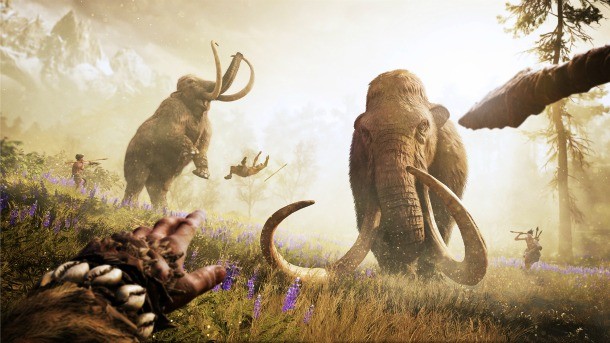
Rather than feeling like a tacked-on Minecraft-lite component, settlement building neatly feeds back into all of the game’s core systems, creating a compelling gameplay loop. Exploration, narrative missions, hunting, gathering, crafting and unlocking new skills are all tied together elegantly in the settlement system, giving each of these individual components more weight and purpose than they’d otherwise have.
Shortt says that the settlement idea, like many of the new gameplay tweaks, sprung organically from Ubisoft Montreal’s research into the period. “This is pre-history, which is a really important notion. We worked with an anthropologist out of the University of Montreal, which was great. He went to the caves in France, and he’s seen the weapons and tools they used. And he was really able to give us a good sense of how Homo sapiens and Neanderthals lived. The Mesolithic Period – when the game is based – is when humans actually started settling, so this is the first time that we have a village that you build.”
Although permanent dwellings clearly have their evolutionary advantages, they also have their downsides. “Humans used to be very nomadic,” explains Shortt. “As they settled, other tribes would settle, and once that happened they started fighting over resources. And then you see wars starting to happen. This period is really the beginning of all that.”
With the first tiny seeds of a new village planted, Sayla sends Takkar on a quest into the wilds to find one of the most important specialists: Tensay, the shaman.
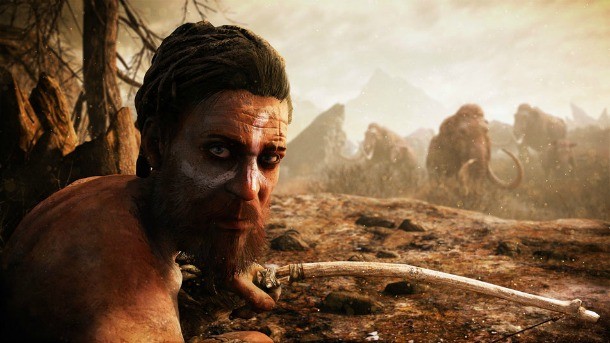
Playing With Fire
The journey to find the village’s new spiritual leader is not uneventful: along the way, scattered bands of Udam warriors become unwilling test subjects for the game’s combat tools.
Firing arrows feels almost identical to earlier Far Cry games, with headshots providing a satisfying thud and a reliable one-shot-kill on unarmoured enemies. Given that the first gun is more than 11,000 years away, you’ll need to become familiar with the bow pretty quickly.
Early on, two melee weapons also round out your arsenal. The club has a wide swinging arc, and can connect with a few enemies in one swipe, but it doesn’t have the reach or power of the spear – which can be thrust directly in front or hurled as a projectile.
Most intriguingly, all your weapons can be set on fire, either by using a carried resource (animal fat) or touching them to an open flame in the environment. The club can be used as a makeshift torch when lit, and will eventually burn down to ash if you don’t extinguish it. Whacking enemies with it while it’s aflame does extra damage and sets them on fire.
Given the series’ pedigree, it shouldn’t come as a surprise to learn that Far Cry Primal’s fire propagation system is a lot of fun to mess with. At one point I shot a deer with a flaming arrow. It fell over into long grass, which promptly caught alight. From there, things escalated.
The blaze spread uphill realistically, burning small trees and the undergrowth, threatening to rage out of control until, thankfully, all the fuel in its path was finally consumed. A large patch of scorched earth left me pondering how I could put my discovery to tactical use in the war against the Udam tribe.
With Takkar’s accidental foray into pyromania over, he finally arrives at the shaman’s cave. Here, events take a serious turn for the bizarre. This is Far Cry, after all.
Through The Looking Glass
Wearing a wolf pelt on his head and performing a dance-like ritual around a campfire, Tensay the shaman doesn’t appear surprised by Takkar’s presence in his cave. “You are the one,” he exclaims in a stilted dialect. “I call strong spirit. Bear, rhino, tiger... then you come!”
Before Takkar can comprehend his ramblings, the shaman seizes his hand, cuts it with a dagger, and pours his blood into an animal skull. He hands Takkar the gruesome, makeshift mug. Takkar drinks. “I love the shaman,” says Shortt. “He brings a lot. He’s colourful, he’s crazy, he’s exotic, but he’s also the anchor for the narrative. He’s the anchor for the entire tribe and he holds their beliefs. He oversees births; he oversees death. He’s a great character.”
Takkar’s vision warps. “Let your spirit walk free,” the shaman says – words spoken in a tone deeper and more powerful than the voice he possessed moments earlier. Takkar falls unconscious for the second time that day. If you’ve been wondering how Far Cry’s signature “trippy moments” would be triggered in Primal, look no further than Takkar’s “spirit visions.”
With the writing team not wanting to travel down the hallucinogenic-substance route again, research into the spiritual beliefs of early humans gave them their solution. “What’s great about the [visions] is you get to go bizarre and have crazy fun with it, but it still reflects the [period],” Shortt explains. “It can’t be outside of that. In Far Cry Primal, we found our [way in] through the shaman. The shaman and the tribe’s belief in animism – that was our window.”
Takkar wakes in an otherworldly forest. Floating islands fill the sky. An ethereal glow lingers in the air. Golden spirit animals congregate around a stream, where Takkar is drawn towards a perched owl. Upon reaching it, the scene evaporates and he finds himself plummeting down a waterfall. But his panic is brief.
As the ground approaches at an alarming rate, Takkar somehow takes flight. In a sequence reminiscent of the wingsuit descents from Far Cry 4, Takkar soars across the river, weaving between the gargantuan trees of the forest, following the owl guide. He warps through another waterfall and finds himself swimming through a deep lake before taking to the skies yet again.
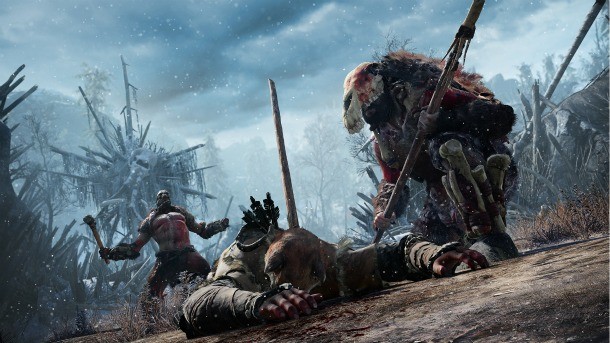
Master Of Beasts
Once Takkar has caught up with the owl, both beast and man land on the forest floor. The bird perches on Takkar’s arm and they lock gazes. “Now you will be my eyes in the sky,” Takkar whispers. He wakes from his spirit vision to see the shaman hovering over him. “You bond with owl,” Tensay exclaims. “The owl spirit names you Beast Master!”
The owl is the first of many animals that Takkar can tame and control in Far Cry Primal. At any moment, pressing up on the d-pad summons the bird. The spiritual connection that Takkar shares with it allows him to see from the owl’s perspective as it soars above the landscape. This is useful for tagging enemies ahead of a stealthy assault and highlighting hard-to-see resources. The owl can even be upgraded with a dive attack that can kill weaker enemies.
“We looked at the era and saw that the Mesolithic Period – and soon afterwards – was an important moment for the domestication of animals,” explains Shortt. “This really changed the way people hunted and how they were able to interact with nature. So we took that idea and added a Far Cry spin on it by saying, ‘In our game, you are going to be the first person who can tame animals.’
“In reality, I don’t think that’s how it actually worked, but that’s the game’s fantasy,” laughs Shortt. “It’s part of the fun, but it’s grounded in the reality of the period.”
The shaman challenges Takkar with taming a wolf as his next conquest. After tracking one with his Hunter’s Vision and luring the snarling beast into the open with bait, Takkar approaches it gingerly. He is able to placate the creature and win the loyalty of a new companion.
Once tamed, the wolf functions as a clear evolution of the spirit tiger from Far Cry 4, stalking along by your side and attacking specific enemies when you highlight them and press R1. If the wolf takes damage in battle, it can be healed using your health resources. If it dies, you can call another.
Flicking to the beast menu reveals more than a dozen tameable creatures, each with their own attributes across three different categories: strength, speed and stealth. The wolf has a measly one strength point, but its speed and stealth are both rated three out of five. More impressive, higher-tier creatures such as the leopard and bloodfang sabre-tooth have far more imposing attributes.
These powerful animals won’t be tameable until Takkar’s Beast Master skills have been upgraded by the shaman later in the game. Eventually, though, not only will Takkar be able to command apex predators to attack his enemies at will, he’ll be able to ride them into battle. Far Cry Primal may not have motor vehicles of any description, but the ability to hop onto the back of a sabre-toothed tiger and charge at enemy tribes seems like a decent replacement.
What Is Far Cry?
For reasons I can’t pin down, I went into Far Cry Primal expecting a less impressive spin-off title – smaller in scope, something that didn’t feel like a “real Far Cry.” Maybe it was the missing number from the title? Perhaps it was the short marketing campaign and the fact that it didn’t leak like so many of Ubisoft’s other triple-A titles?
But, after playing it for four hours, I’ve shaken off that initial impression. If anything, this feels more like a true sequel than Far Cry 4 – a game I never actually finished because I found it too similar to Far Cry 3.
Stepping back in time 12,000 years is an unexpected approach, but it’s one that works surprisingly well. It also begs the question: what exactly is Far Cry? From the robotic dinosaurs of Blood Dragon to the Himalayan peaks of Far Cry 4 to the prehistoric lands of Primal, are there any limits? Can a Far Cry game be anything? Deep scape? The future? Australia?
“As long as it’s a frontier where the rules are different and survival is a key theme – as long as you’re on your own facing an unknown situation – then yes,” says Shortt. “If you hit on those things you could set Far Cry anywhere.”
Although much of the franchise’s DNA remains intact, the prehistoric setting goes a long way towards reinvigorating the core – not only in an aesthetic sense, but also by inspiring new period-appropriate gameplay elements.
Settlement building, taming beasts, spirit visions, experimenting with flaming weapons, warring with hostile tribes: all these features feel new and perfectly at home within the Far Cry franchise. And you can’t deny the sheer audacity of releasing a first-person shooter that doesn’t have a single gun.
Editor's Note: The following article first appeared in Game Informer Australia Issue #75 and is written by David Milner. You can follow him on Twitter here.
